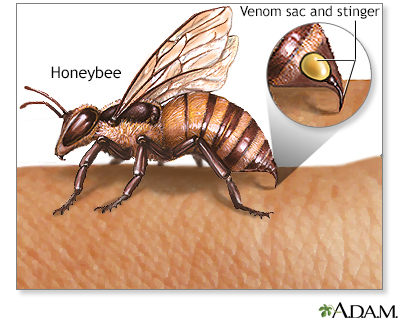| Insect stings |
Insect and spider bites can cause an allergic reaction. Stinging insects (such as honey bees, yellow jackets, hornets, wasps, and fire and harvester ants) are more likely to cause an allergic reaction than biting insects (mosquitoes, horseflies, deerflies, spiders, bedbugs, and black flies).
Most bites and stings do not require emergency medical care. However, a small number of people develop severe allergic reactions (anaphylaxis) to insect stings.

Allergic reactions to insect bites or stings occur very quickly, usually within minutes. Severe reactions, although rare, can be rapidly fatal if untreated. According to the American Academy of Asthma, Allergy, and Immunology's 2007 Allergy Statistics:
- At least 40 deaths occur annually in the United States from reactions to insect stings. A severe allergic reaction known as anaphylaxis occurs in 0.5 - 5% of the U.S. population as a result of insect stings.
- Venom immunotherapy prevents systemic reactions in patients sensitive to insect stings 97% of the time.
Symptoms
Common symptoms include:
- Red, swollen, or warm lump
- Hives
- Rash
- Itching, tingling, numbness, burning, tenderness, pain
Serious allergic reactions (anaphylaxis) occur when symptoms spread. These can include difficulty breathing, dizziness, nausea, diarrhea, fever, muscle spasms, or loss of consciousness. If any of these symptoms occur, call for emergency medical help right away.
First aid for minor reactions
- If the sting is from a honey bee, remove the stinger from the skin if it is still present. Carefully scrape the back of a knife or other thin straight-edged object across the stinger if the victim can remain still, and it is safe to do so. Otherwise, you can pull out the stinger with tweezers or your fingers, but avoid pinching the venom sac at the end of the stinger which will cause more venom to be released.
- Wash the site thoroughly with soap and water.
- Cover the site with a clean, cold compress or a clean, moist dressing to reduce swelling and discomfort.
- Over the next 24 - 48 hours, observe the site for signs of infection (such as increasing redness, swelling, pain).
- Sores from scratching can become infected. Keep bites clean and, to prevent infection, don't scratch.
First aid for serious reactions
If the person is having a severe reaction or has been stung inside the mouth or throat, call 911 immediately for emergency medical assistance.
- Check the person's airway, breathing, and circulation. If necessary, begin rescue breathing and CPR.
- Use a special allergy first aid kit, including an epinephrine pen, if available. (Some people who have serious insect reactions carry one with them.)
- Reassure the person. Try to keep the person calm, as anxiety will worsen the situation.
- Remove rings and constricting items because the affected area may swell.
- If appropriate, treat the person for signs of shock. Remain with the person until medical help arrives.
Treatment
Non-serious, local reactions usually go away in three to seven days with no treatment. For symptom relief, use an ice pack or wet compresses. (Or, 1 tsp. meat tenderizer mixed with 1 tsp. water applied to bite.)
Drug therapies include:
- Antihistamines and anti-inflammatories for itching and swelling
- Topical and oral steroids (may be prescribed by your physician)
- Antibiotics (if infection occurs)
If the reaction is serious enough that a hospital visit is warranted, antihistamines may be given intravenously and epinephrine (adrenaline) may be administered. Sometimes serious reactions happen again soon after the first reaction stops. Your provider may want to observe you for 8 - 12 hours.
Preventing insect stings and bites
- Avoid provoking insects whenever possible.
- Avoid rapid, jerky movements around insect hives or nests.
- Avoid perfumes and floral-patterned or dark clothing.
- Use appropriate insect repellants and/or protective clothing.
- Use caution when eating outdoors, especially with sweetened beverages or in areas around garbage cans which often attract bees.
If you have had a serious reaction to an insect bite, keep an emergency insect sting kit and wear a medical alert bracelet.
Reference
Golden DB, Moffitt J, Nicklas RA, et al. Stinging insect hypersensitivity: A practice parameter update 2011. J Allergy Clinical Immunology. April 2011;127(4):852-854.e23.
Reviewed By: Paula J. Busse, MD, Assistant Professor of Medicine, Division of Clinical Immunology, Mount Sinai School of Medicine, New York, NY, Review provided by VeriMed Healthcare Network. Also reviewed by David Zieve, MD, MHA, Medical Director, A.D.A.M., Inc.
